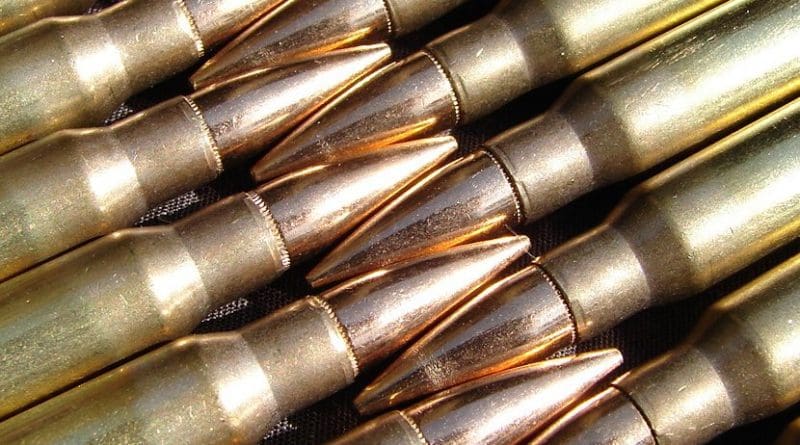Global Arm Sales: Change Is Underway – Analysis
By Observer Research Foundation
By Harsh V. Pant and Kartik Bommakanti
A significant shift away from the world’s major weapons producing region is underway, with impressive gains for China and to an extent India
The world witnessed a significant surge in arms sales from countries in the Asia-Oceania region in 2021. Despite supply related disruptions due to the Covid-19 pandemic, arms sales by the 100 most important weapons manufacturing companies stood at $592 billion, representing an increase of 1.9 per cent from 2020.
According to the Stockholm International Peace Research Institute (SIPRI), in aggregate terms, arms sales from Asia and Oceania increased by 5.8 per cent to $136 billion, surpassing weapons sales from Europe by a considerable $13 billion. This represents a significant shift away from a major weapons producing region, which has historically been dominated by defence industrial power centres, especially in the case of Europe, but less in North America (which includes the United States and Canada).
While specifically the United States still remains ahead of all the major arms producing countries and regions — notwithstanding a dip of 0.9 per cent in weapons sales from 40 of its top weapons manufacturing companies at $299 billion in 2021 — the rise in Chinese weapons sales is a portent of things to come. For the year, the People’s Republic of China (PRC) alone accounted for a little over 80 per cent of the weapons sales in the Asia and Oceania region, with eight of the PRC’ top companies generating combined sales worth $109 billion, representing an increase of 6.3 per cent compared to 2020. Japan was a distant second with South Korea ranking third and India fourth.
Thus, the prime gainer in this growth of weapons sales in 2021 is the Chinese defence industry. It reflects China’s rise as a major weapons exporter that is increasingly playing a role in the global defence market commensurate with the size of its $17-trillion economy. There are several factors explaining China’s performance, but two key things standout — Beijing’s commitment to self-reliance in defence technology and the mergers of key industries cementing greater consolidation in the Chinese defence industry. Self-reliance has come in the form of sustained Chinese investments since its inception as a Communist State in 1949-50. Today, China is reaping the dividends of those early investments. The PRC’s second crucial achievement has come by way of a combination of factors – technological espionage, deep investments in weapons Research and Development (R&D) and reverse engineering, which has helped it indigenise capabilities from tanks, artillery, weapons and aircraft engines to warships and submarines. That apart, the Chinese defence industry has done so at scale, and is capable of mass production of weapons systems for a range of clients extending from the People’s Liberation Army (PLA) and all its service arms to overseas buyers.
According to SIPRI’s latest report, Beijing undertook some key changes in its defence industry notably by merging China Shipbuilding Industry Corporation and China State Shipbuilding Corporation (CSSC) into a single entity, which was a reversal of earlier practices geared towards augmenting productivity and competitiveness. The CSSC was the 14th largest weapons seller in the world with sales touching $11.1 billion, making it the largest shipbuilder in the world in 2021. However, the SIPRI report did not reveal the breakdown of the PRC’s impressive weapons sales to ascertain whether the PLA, PLA Navy and PLA Air Force were the primary buyers of Chinese weapons systems, or whether the bulk of the revenue came from exports. Historically, the Chinese military has been a major investor in the Chinese defence industry and it would be unsurprising if its armed forces was the primary buyer of Chinese weapons for the year. Nevertheless, the PRC is a major exporter of weapons and exports would constitute a sizable share of the country’s weapons sales.
Meanwhile, India too saw improvements in its arms sales in 2021. Two Indian companies, Hindustan Aeronautics Limited (HAL) and Bharat Electronics Limited which ranked 42nd and 63rd respectively for arms sales saw sales surge by 6.7 percent and 20 percent respectively though in years past, their principal clients have been the Indian armed forces. As in the case of the PRC, the SIPRI data does not provide the precise composition of military sales to specific clients. The Ordnance Factories figured on the list of the top 100 weapons companies in 2020 but have historically lacked vigour in terms of competitiveness and productivity. Their restructuring in October 2021 into seven smaller companies, however, induced their exclusion from the top 100.
The test going forward will be whether India can move towards a fully privatised defence industry along the lines of the US or advance towards a defence industrial complex that emulates the PRC. Irrespective of China’s growth profile in the world armament industry, the US remains the world’s foremost weapons manufacturing and exporting country. Nevertheless, there is no reason for China not to catch up and become an even more consequential competitor to the US. For India, while HAL and BEL made impressive gains in 2021, the government could break up HAL and BEL, which are state-run monopolies in a quest to boost productivity and competitiveness and then, over time, emulate the Chinese and consolidate them under a single entity.

